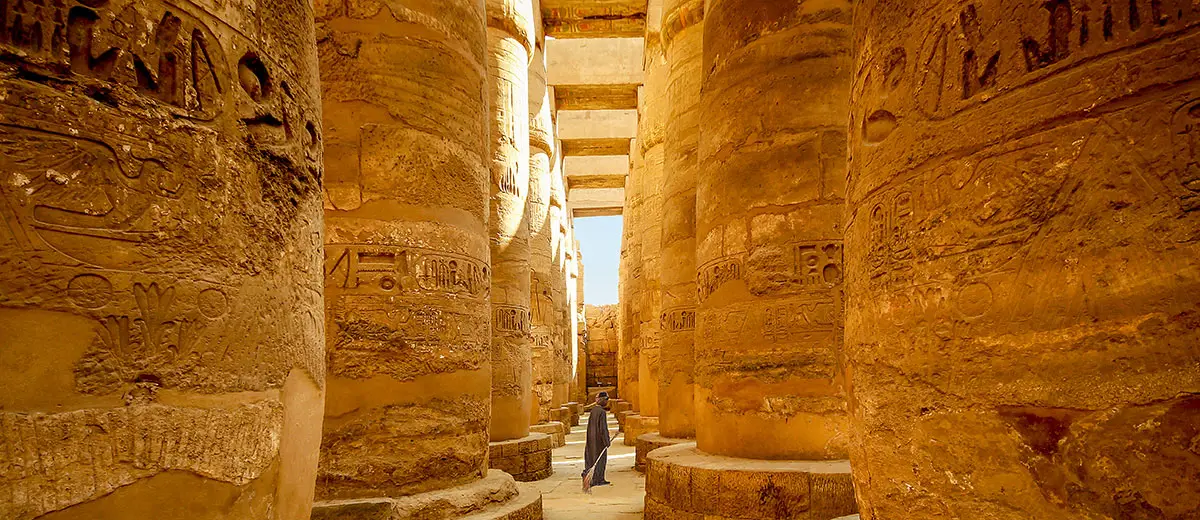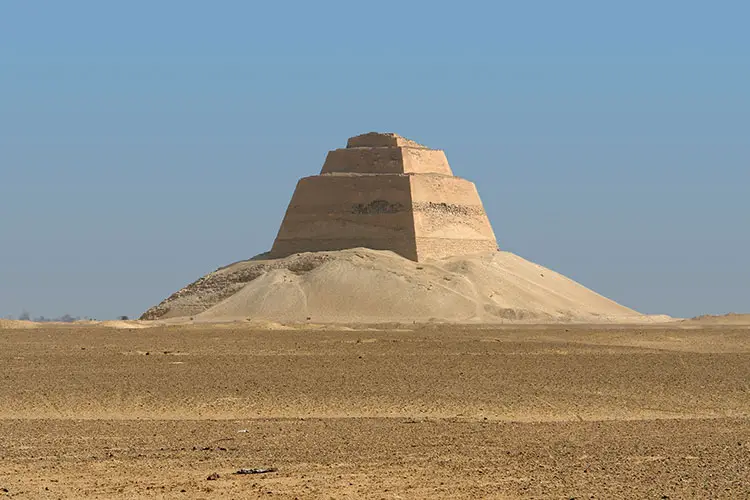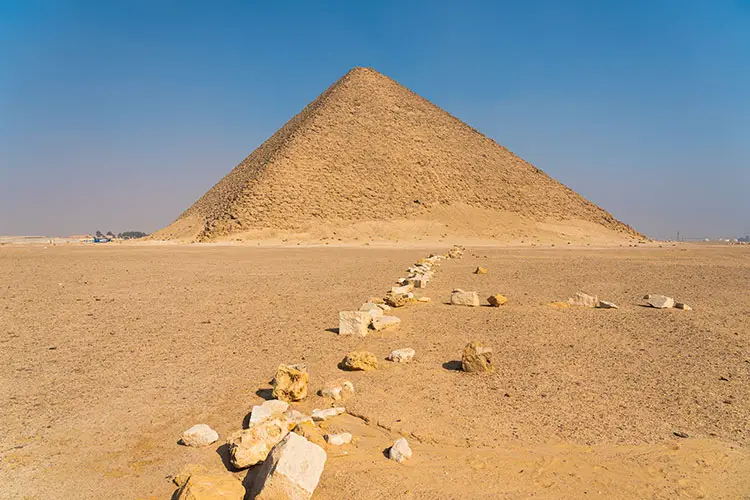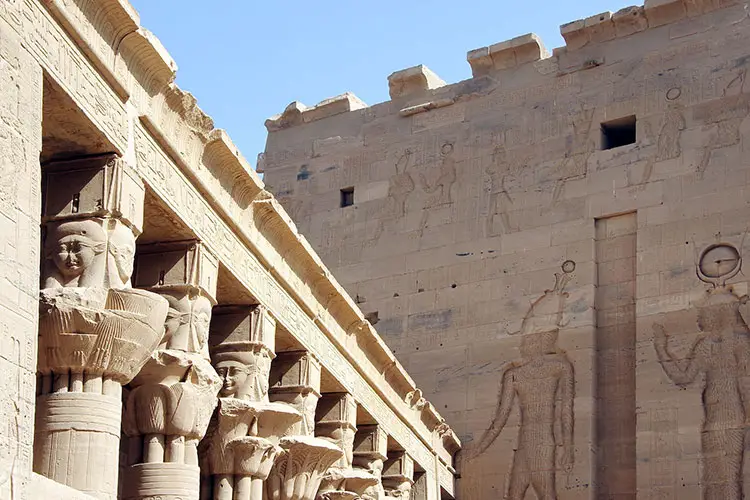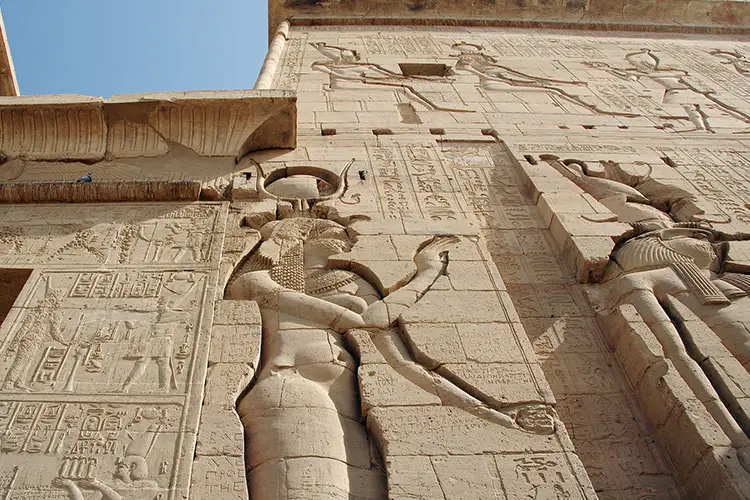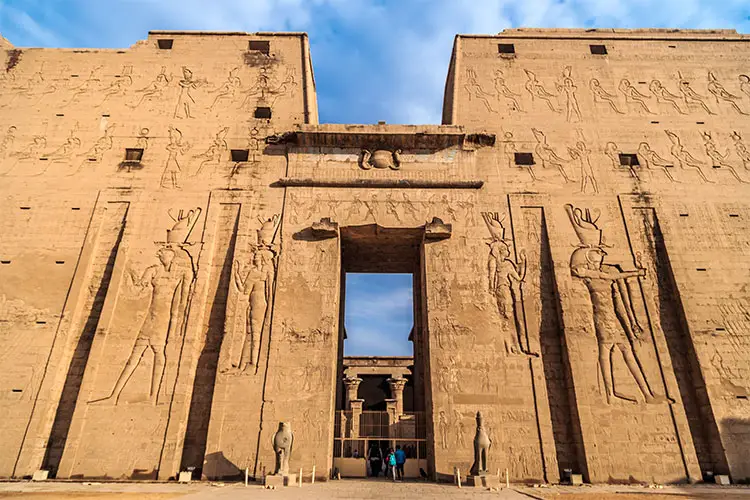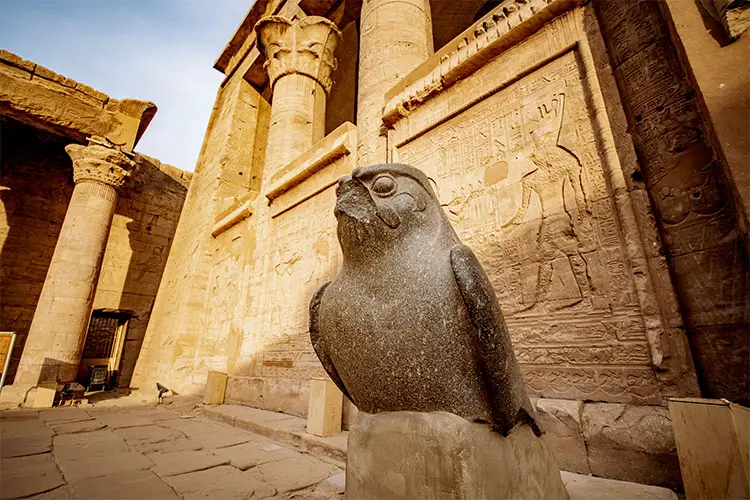A Brief History of Ancient Egypt & Where it was Located
Spanning 3 millennia from the unification of states in 3100 BC to the Roman conquest in 30 BC, the history of Ancient Egypt is an epic tale, which includes the three great kingdoms, several periods of chaos and near ruin, and invasions by the Persians, the Greeks and ultimately, the Romans. After many years of archaeological study, we are now able to better understand what life may have been like for the world’s first great civilization.

Contents
- Predynastic Period | Up to 3100 BC
- Early Dynastic Period | 3100 – 2686 BC
- Old Kingdom | 2686 – 2181 BC
- 1st Intermediate Period | 2181 – 2055 BC
- Middle Kingdom | 2055 – 1650 BC
- 2nd Intermediate Period | 1650 – 1550 BC
- New Kingdom | 1550 – 1069 BC
- 3rd Intermediate Period | 1069 – 664 BC
- Late Period | 664 – 332 BC
- Ptolemaic Period | 332–30 BC
← Watch Out!
Keep an eye out for the bucket-list icon! There are examples and photos of famous sites and relics sprinkled throughout this guide that pertain to each period. This article is part of a three-part series on Ancient Egypt. There are more of the famous sites featured in both What Ancient Egypt was Known For and The Best Places to See Ruins of Ancient Egypt if you’re interested in reading those too.
Predynastic Period | Up to 3100 BC
In the same manner as their contemporaries in the Indus Valley and Mesopotamia, for millennia small tribes began congregating on the fertile banks of the Nile River, which facilitated irrigation leading to further development of agriculture and, ultimately, the advent of civilization. As society began to progress, these small tribes banded together to form two larger populations; Lower Egypt—based around the Nile Delta, on the banks of the Mediterranean—and Upper Egypt—located further upstream, adjacent to the Red Sea.
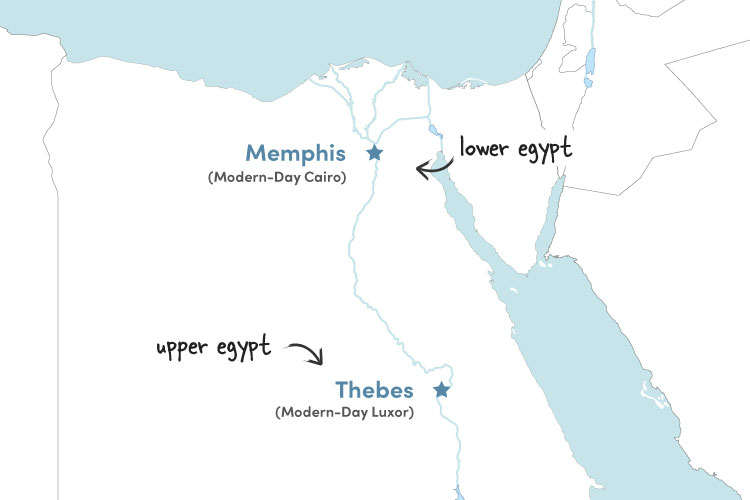
Early Dynastic Period | 3100 – 2686 BC
The beginning of Egyptian civilization is generally considered to coincide with the consolidation of Upper and Lower Egypt. It is said that King Narmer—who ruled over Upper Egypt at the time—conquered Lower Egypt, setting up the first dynasty. The period between the unification of these states in 3100 BC and the Macedonian invasion in 332 BC is split up into 30 dynasties, hence, it is known as The Dynastic Period and contains most of Egypt’s most beloved ruins and relics.
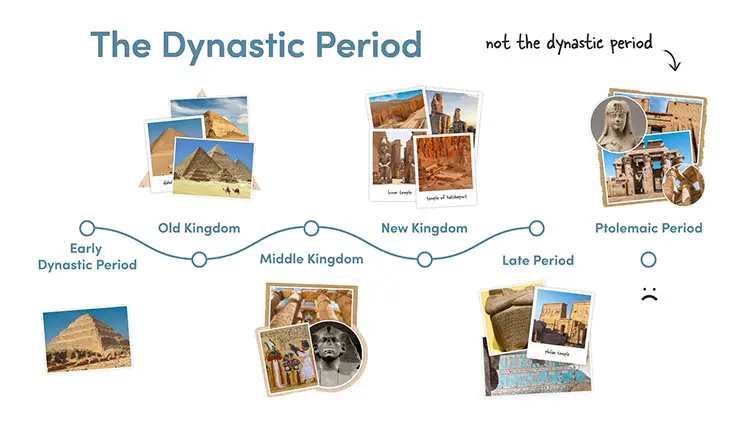
Two clear centres began to develop during this period: Thebes—modern-day Luxor—became the capital of the upper section of Egypt and Memphis—just south of modern-day Cairo—was created to administer the lower section of the country and was the epicentre of Egypt’s pyramid construction.
Saqqara Necropolis
Measuring 7km long by 1km wide, this sprawling necropolis contains burial sites from the entire Dynastic period making it one of the most historically rich sites in all of Egypt. Designated a UNESCO World Heritage Site in 1979, Saqqara contains a massive collection of pyramids and tombs, which sit atop an arid plateau with Cairo’s modern-day skyline as its backdrop.
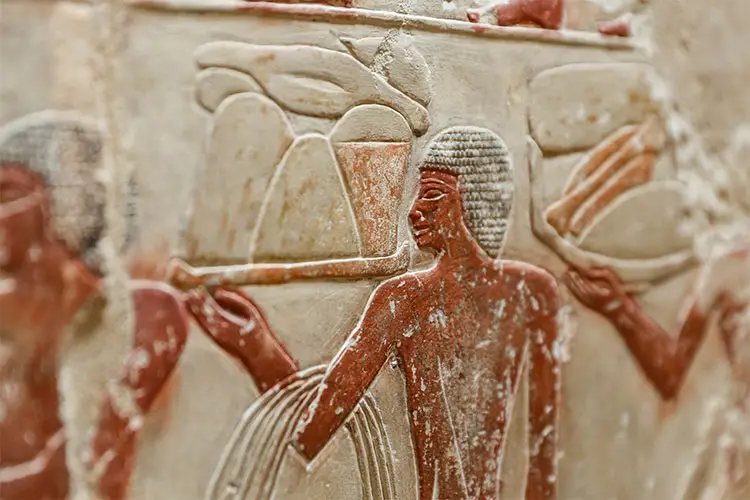
Although the pyramids here pale in comparison to those at Giza, Saqqara plays an important role in the development of pyramid building. This necropolis also tends to be a much quieter setting so, if like me, you prefer to avoid the crowds, Saqqara is well worth considering. Perhaps the most famous of the structures at Saqqara, the Pyramid of Djoser—aka the Step Pyramid—was built during the Old Kingdom and is one of the earliest epic stone structures in Egypt. Speaking of which…
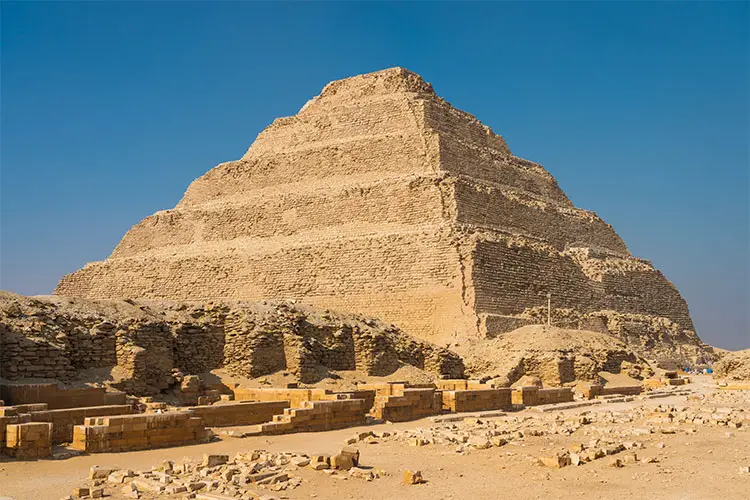
Old Kingdom | 2686 – 2181 BC
The first of the three Kingdom periods, this roughly 500-year span covers the 3rd to the 6th dynasties and contains the most famous of all Egyptian ruins: the Pyramids of Giza and the Great Sphinx. As Egyptian civilization advanced so did the wealth and status of the king and the underlying class structure. Memphis became the administrative capital of Egypt and the nearby limestone plateau of Giza was selected as the location for their most ambitious engineering projects to date.
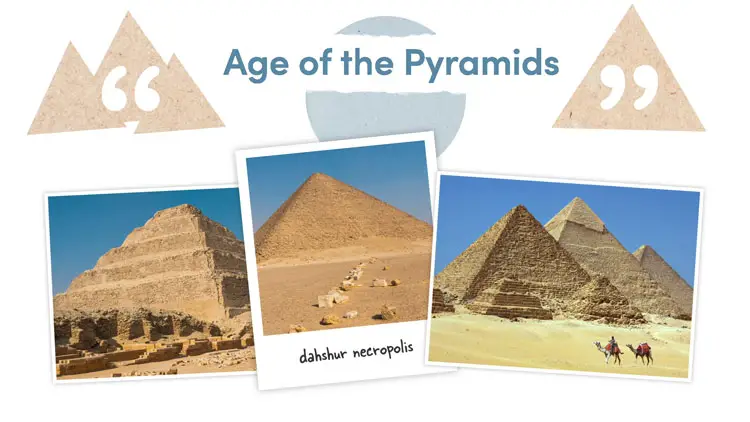
The peak of this period came during the 4th dynasty, when a succession of pyramid-building pharaohs expanded on their predecessors’ work, culminating in the reign of Khufu—2589–2566 BC—who built the 455ft Great Pyramid of Giza. Within a 45 minute drive from Cairo city centre, one could pass by Giza, Saqqara and Dahshur (Although I would recommend stopping at each!) as well as some of the country’s best museums.
Dahshur Necropolis
If you want to get super nerdy, I would highly recommend visiting the Saqqara Necropolis first, then Dahshur, then Giza! Known as the “Age of the Pyramids”, engineering and construction progressed dramatically over the course of the Old Kingdom; Step pyramids were constructed first—the aforementioned Pyramid of Djoser being the best example—then they really stepped things up (pun intended) with straight, diagonally sided pyramids.
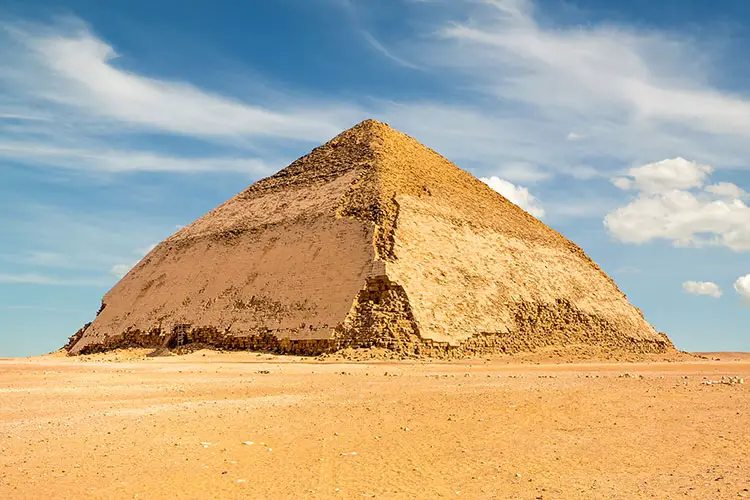
There are several examples at the Dahshur Necropolis that not only illustrate this transition but also help tell the most heartwarming father-son story I have ever come across. Ready?
Having taken a bash at a step pyramid, king Sneferu set out to build his very first straight-sided structure but as these first attempts usually are, it was a bit of a disaster. As well as placing his pyramid on soft ground, he failed to correctly calculate the weight distribution of the blocks leading to its unfortunate moniker, the Bent Pyramid. Not one to be easily discouraged, Sneferu set out to build a bigger, better, straighter pyramid and, while I couldn’t verify the dates, it’s possible that his son, Khufu would have accompanied his father to the job site (see where this is going?!).
Sneferu’s first and third pyramids | Left – Meidum Pyramid & Right – Red Pyramid
The Red Pyramid was a success and stood at 341 ft with an angle of 43 degrees, sadly, it is also said to be Sneferu’s final resting place. Building upon his father’s work, king Khufu then selected the limestone slab at Giza as the base for his pyramid and successfully executed the greatest engineering project of all time, the Great Pyramid of Giza, which stands at a staggering 481 ft with a 52-degree angle. How proud would you be if you were Sneferu?!
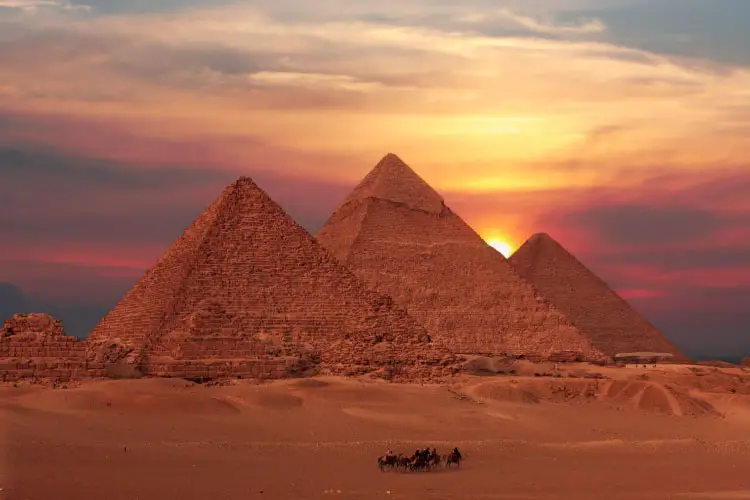
1st Intermediate Period | 2181 – 2055 BC
Every civilization ebbs and flows from periods of economic prosperity to times of hardship and strife; Ancient Egypt is no exception. The lavish lifestyle of the kings is thought to have taken a toll on Egypt’s economy and long periods of drought towards the end of the Old Kingdom ushered in the first of three intermediary periods. Following the collapse of the hierarchy that once ruled the country, each province developed its own governmental structure and social equality actually improved during this time. In similar fashion to the inception of Predynastic Upper and Lower Egypt, two powerhouses began to emerge in their respective halves. Eventually, this culminated in a victory for Thebes, transferring the country’s administrative capital to the site of modern-day Luxor.
Middle Kingdom | 2055 – 1650 BC
A united kingdom meant a unified workforce, which led, once again, to the development of large scale projects and additional efforts being made towards the progression of the arts and engineering.
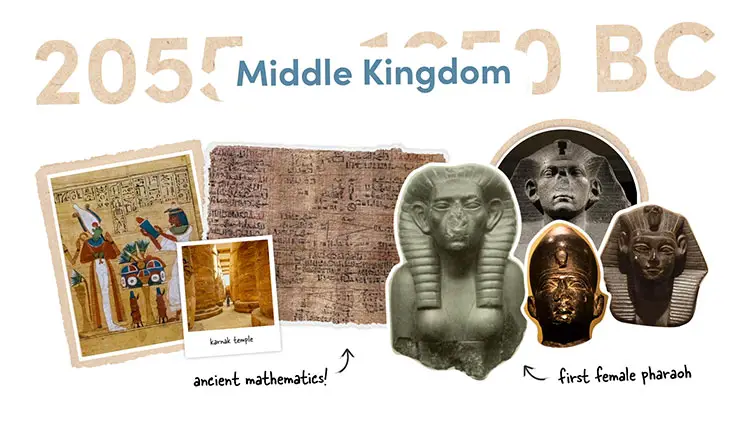
Although Thebes was the main centre during the start of the Middle Kingdom—and thus where you will find most of the famous ruins from this period—the capital was eventually moved back towards modern-day Cairo. It is said that King Amenemhat I—1991-1962 BC—shifted the capital back to the Lower section of Egypt (in the north, I know, it’s super confusing!) to help protect against Asiatic invasions.
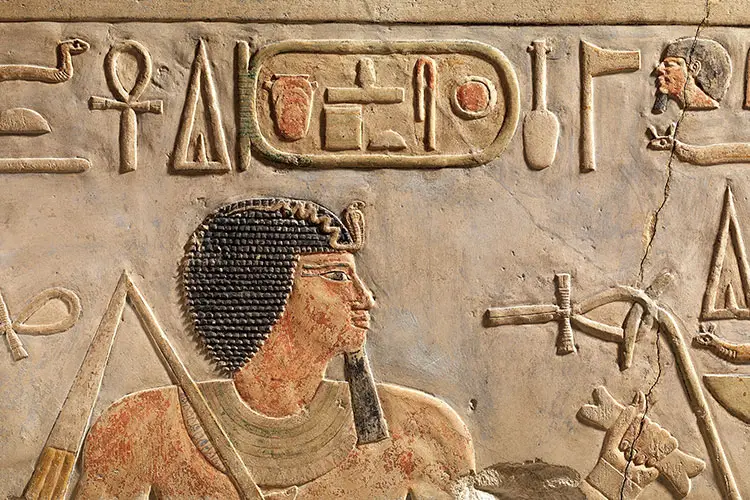
Having learned a thing or two from their pharaonic brethren in the Old Kingdom, it sounds like the rulers of the Middle Kingdom at least attempted to be more economically inclusive, but alas. The same combination of large scale projects straining the economy and natural disasters—this time flooding in the Nile Delta region—led to the second intermediate period and, once again, the collapse of the ruling class.
Karnak Temple Complex
The second most visited historical site in Egypt, Karnak sits on the western bank of the Nile in downtown Luxor. The size of the complex is vast, with only one of a total of four precincts actually open to the public while the others are being restored. It was initially constructed in the Middle Kingdom and was added to, improved on and repaired over time—mostly in the New Kingdom.
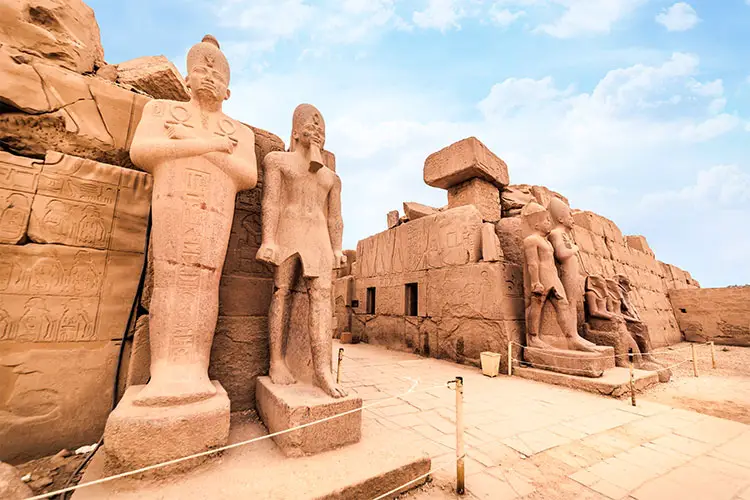
Each precinct is dedicated to a different god with the largest of the four—and the only one currently open—dedicated to Amun-Re. One of the most renowned parts of this complex is the Great Hypostyle Hall, which was built somewhere between 1290-1224 BC during the 19th Dynasty. It contains over 100 columns covered by a fascinating collection of inscriptions mainly left by Seti I and Ramesses II. Karnak also boasts an open-air museum, which contains reconstructions of what the complex would have looked like in its heyday.
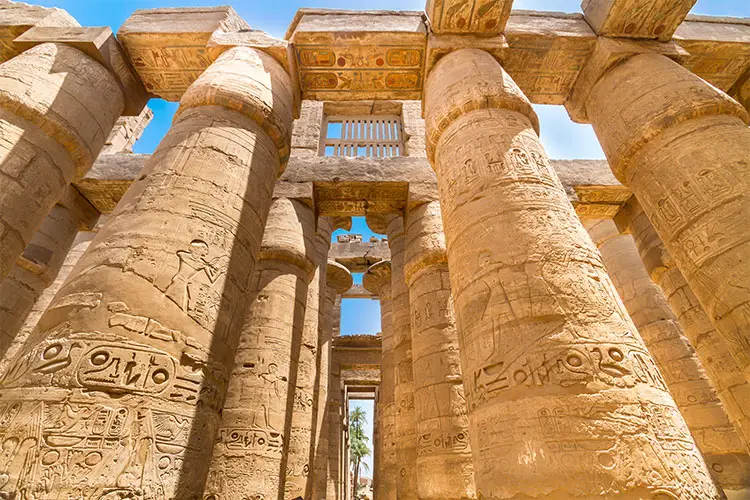
2nd Intermediate Period | 1650 – 1550 BC
Tragically, this second intermediary period was characterised by war with the move to Memphis proving insufficient in stifling invasion. During this period, Ancient Egypt was almost totally annihilated, stuck between Hyksos—meaning “rulers of foreign lands”—in the north and the Kushites in the south. After the northern invasion, the Egyptians retreated back to Thebes where they recouped and fended off attacks from both sides. But, to be fair, things could have been worse. Like the Greeks who followed much later, Hyksos integrated with Egyptian society and are credited with advancements such as the horse and chariot and the terrifying innovation of the composite bow. Eventually, the centre at Thebes mustered up enough strength to not only expel the Hyksos forces from the north but to expand their territory east into the Levant.
New Kingdom | 1550 – 1069 BC
If there is one lesson we could take away from Ancient Egypt (which we definitely haven’t!) it would be modesty. Unsurprisingly, the New Kingdom brought with it unseen boundaries of wealth, territory and construction, which all came crashing down thanks to opulence and greed.
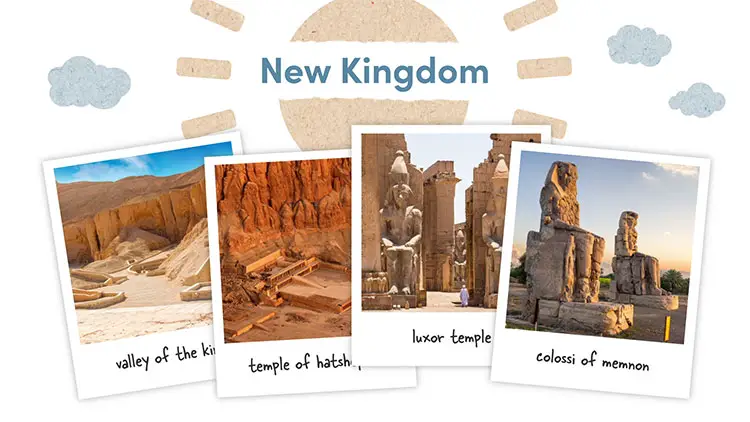
During this period, Egypt extended their land as far north as present-day Turkey, which provided valuable trading opportunities with, among others, the Hittites and the Assyrians. Societal equality also took another giant leap during the New Kingdom with the rule of the first great female pharaoh. Although the Ptolemaic’s Cleopatra is certainly the most famous and the Middle Kingdom’s Sobekneferu being the first—with a short rule of only 4 years—Hatshepsut is celebrated as one of the most successful pharaohs in history and her legacy remains today just northwest of Luxor city-centre. Just over 100 years after Hatshepsut, another of Egypt’s most well-known pharaohs, Tutankhamun also ruled Egypt. King Tut rose to the throne at an astonishing age of 8 or 9 before tragically succumbing to multiple medical disorders at just 18 or 19 years old. His immaculate golden mask can be viewed in the Egyptian Museum in Cairo.
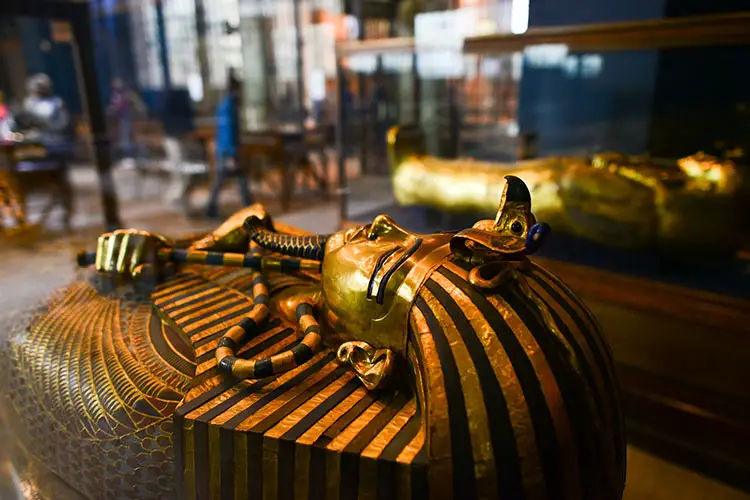
Mortuary Temple of Hatshepsut
This might be my favourite ruin in all of Egypt. First and foremost it’s setting; this UNESCO World Heritage Site was built in front of spectacular red-limestone cliffs at Deir el-Bahari, which also houses the mortuary temples of several other pharaohs. Before considering its construction, contemplate the precision with which it is built; during the winter solstice sunrise each year, the sun shines through specific parts of the temple illuminating various statues of the gods. This occurs around December 21st/22nd every year and would be incredible to watch, I’m sure.
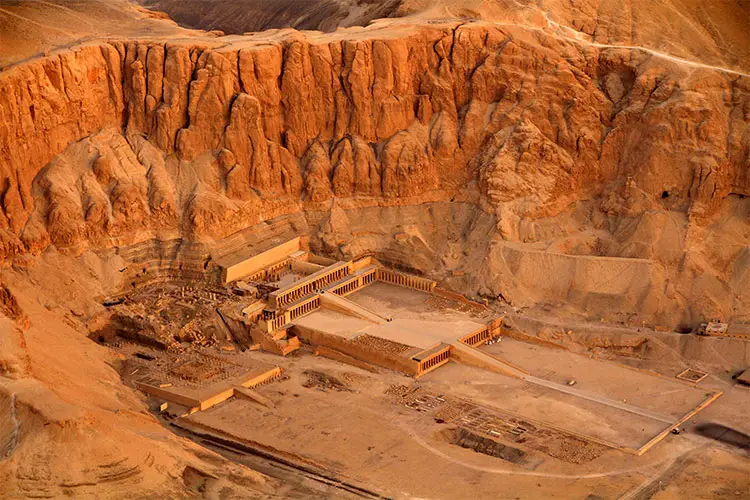
In a drastically different style to a lot of other burial sites in Ancient Egypt, the structure itself is made up of three levels—each reaching almost 100ft in height—accessed by enormous limestone ramps. As you would expect, the decoration of this temple is also incredible and, if you look carefully, depicts the divine birth of a female pharaoh. Deir el-Bahari is very close to the Valley of the Kings on the northwestern side of Luxor.
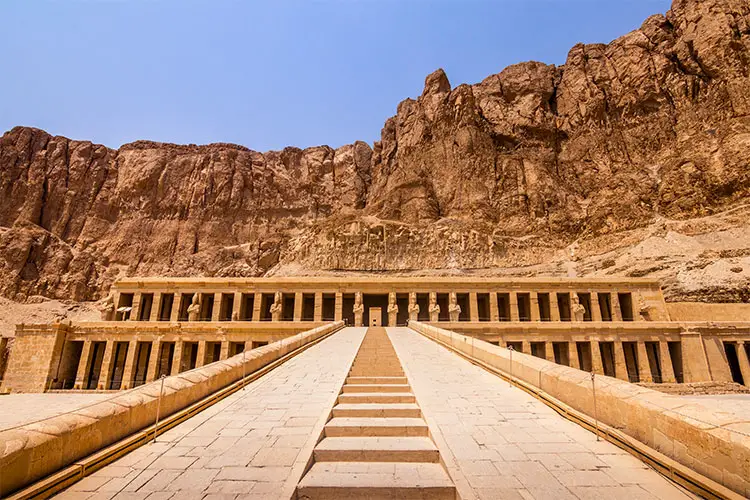
3rd Intermediate Period | 1069 – 664 BC
Here we go again. The New Kingdom is largely thought of as the height of Egyptian Civilization but this affluence would eventually create civil unrest and the allure of Egypt’s riches led to further invasions and the demise of this great kingdom. With the Libyans this time conquering Lower Egypt and the Kushites again attacking from the south, the Egyptians were once more pushed back to Thebes. Eventually, the entire kingdom fell to the Kushites who reclaimed much of the Lower section too and set up the 25th Dynasty of Egypt. This period ends with yet another invasion, this time by the Assyrians who forced the Kushites back into Nubia. With battles to fight on other fronts, Assyrian rule of Egypt diminished and Psamtik I seized control, unifying Egypt in 664 BC with the creation of the 26th dynasty.
Late Period | 664 – 332 BC
This period marks an important turning point in Egyptian history, especially in areas such as architecture and currency; during his 54-year rule, Psamtik I began to develop ties with Greece who were in the process of establishing themselves as the leading power in the Mediterranean.
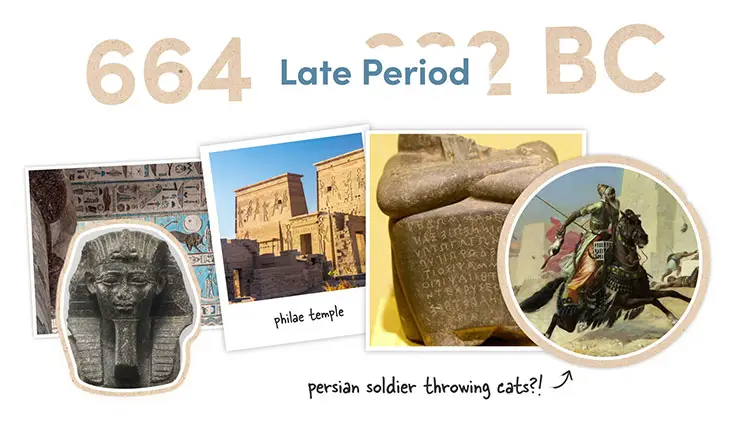
It was during this time that Greek colonies began to appear in Lower Egypt and their influence began to creep into, among other things, Egyptian architecture; Egyptian capitals from this and the succeeding period, in my opinion, are more intricate and more closely resemble their Corinthian counterparts.
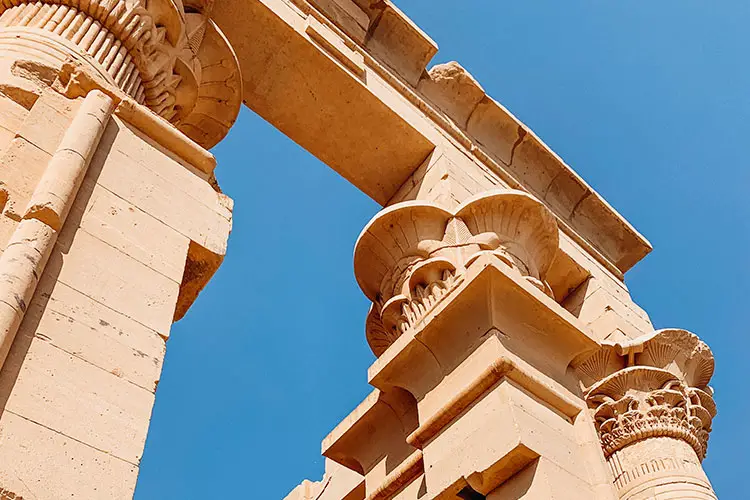
This seemingly blissful cosmopolitan age was short-lived, however, as the last 200 years of the Late Period was spent battling the Persians—the Achaemenid Empire seized control of Egypt several times in between Egyptian revolt and recapture. This territorial game of tug-of-war was finally squashed in 332 BC by the spectacular conquest of Alexander the Great, who came from Macedon—a kingdom in Ancient Greece—to abolish the entire Persian Empire in one fell swoop.
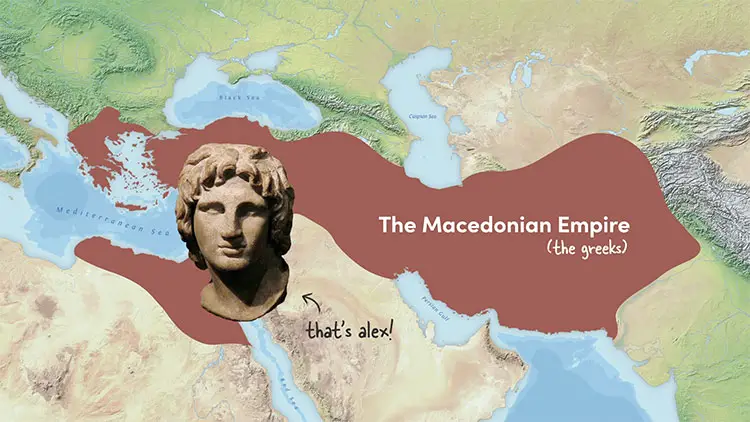
Temple of Philae
What makes this example from the Late Period so compelling a story for me, was not its history during ancient times—which is also fascinating—but the rescue project that was undertaken during the 60s by UNESCO to save this important site. Philae is an island on the Nile and was the site of various temples including one dedicated to the ancient Egyptian goddess, Isis. This was the main structure built on the island during the Late Period and the temples there were further expanded during the Ptolemaic Period.
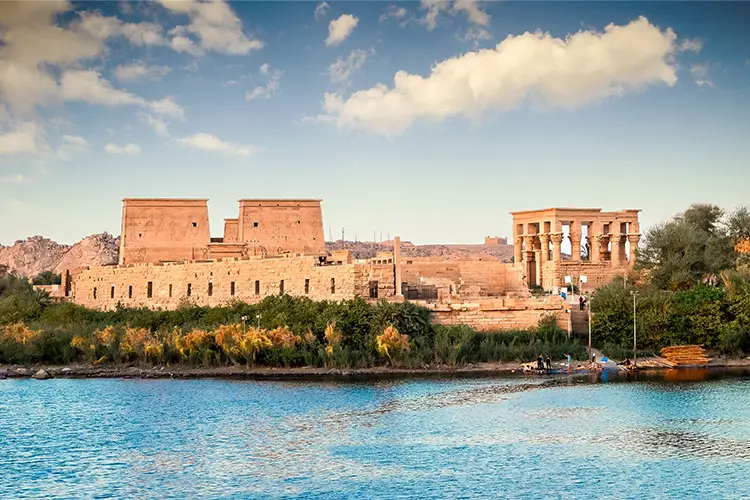
Skip ahead to the 1900s and the building of the Aswan Low Dam. As the dam was extended over time, the temple was often partially submerged in water, this was causing irreparable damage to the colourful inscriptions so it was decided by UNESCO to relocate the whole building. The temple was broken down into 40,000 units and, using photogrammetry, was near-perfectly assembled on a neighbouring island 500m away. Pretty amazing, right? As you’ve probably guessed by the name of the dam, Philae—and its new site on Agilkia Island—is located just south of Aswan at the first cataract of the Nile.
Capitals & sunk relief at the Temple of Philae in Aswan
Ptolemaic Period | 332–30 BC
Given their previous ties to Greece and dislike of the Persians, the Egyptians welcomed the Greeks into their country. Alex’s empire was short-lived, however, and upon his death was split up between his generals with Ptolemy I Soter—a companion of Alexander the Great— forming the Ptolemaic Dynasty, which ruled Egypt for 275 years.
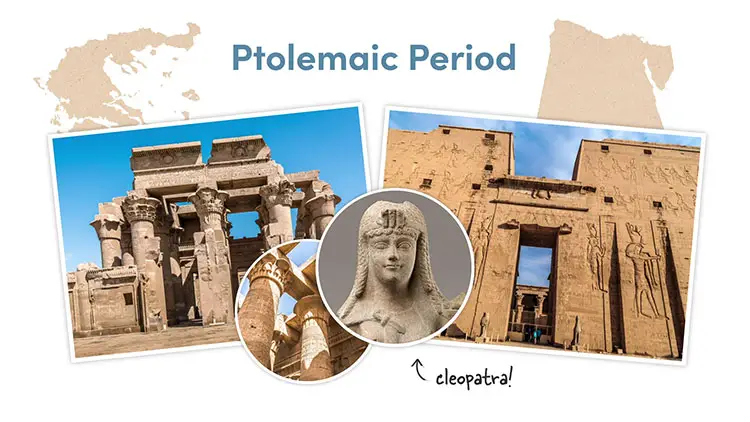
With the country’s capital now moved to Alexandria, Greek Drachma was used as currency and many other Greek customs were integrated into Egyptian society. The Ptolemaic ruling class made many accommodations in an attempt to appease the Egyptian population but inevitably civil unrest began to brew and this turmoil did not go unnoticed by the growing Roman Republic. Quite frankly, the drama that Cleopatra and Mark Antony caused between the Romans and the Egyptians is far beyond the scope of this small paragraph. If I do decide to rant about it, I will come back and leave a link here. To sum up: the Roman’s—realising the importance of Egypt—seized this opportunity, invaded the country and added it to a growing list of provinces of what would become the Roman Empire.
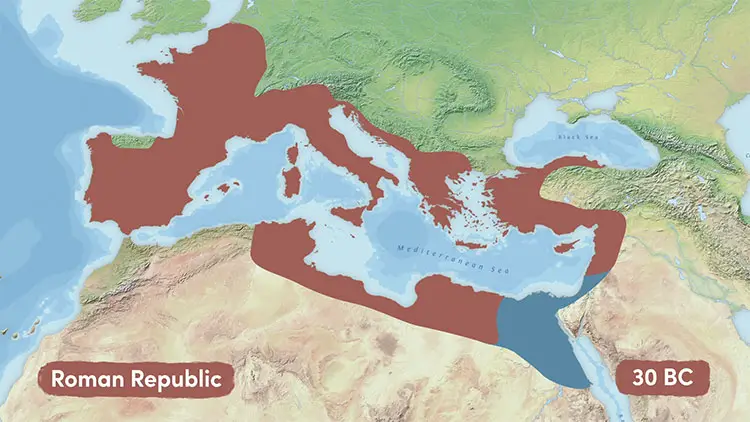
The Temple of Horus at Edfu
Edfu is a city located roughly halfway between Aswan and Luxor; it sits on the western bank of the Nile and contains one of the best-preserved temples in Egypt. Dedicated to Horus—one of the Egyptian gods—the temple was built during the Ptolemaic Period and features a huge flat wall at its entrance, decorated with equally huge inscriptions.
Temple of Horus w Statue of Horus the Falcon God
The inside of the temple exhibits some of the most interesting architecture from this period—the main courtyard surrounded by large pillars with Greek-influenced Egyptian capitals. Horus served many functions and he was often depicted as a falcon and worshipped as the god of the sky, hence the falcon statues inside the main courtyard and at the entrance. There are also several other Ptolemaic temples that are well worth checking out if you’re around Edfu.
